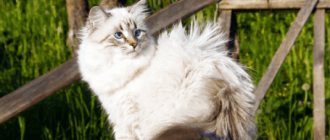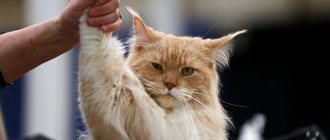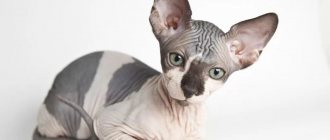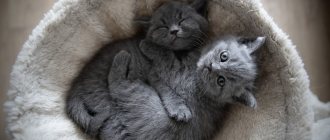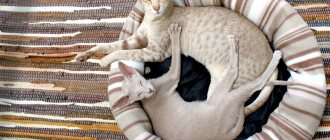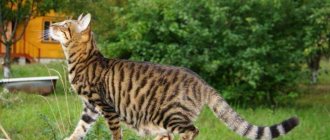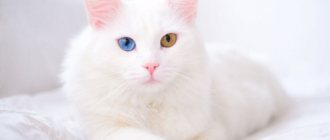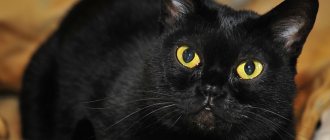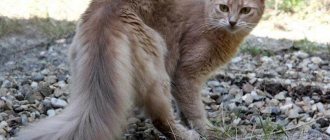- Pets
- >>
- Cat breeds
* Here is a photo of a typical representative of the Neva Masquerade cat breed . You can send us photos of your animals by email, and we will post them on the website. Don't forget to send your pet's name.
Video
* We invite you to watch a video about the Neva Masquerade cat . In fact, in front of you is a playlist in which you can select and watch any of 20 videos about a given cat breed by simply clicking on the button in the upper right corner of the window. In addition, the material contains quite a lot of photos. By looking at them you can find out what the Neva Masquerade cat looks like.
In this article:
|
Rate the material!
[Total votes: 1 Average: 5]
The Neva Masquerade cat is an aristocrat of the cat world. These mannered, graceful animals were bred in Russia and acquired unique character traits. For all their aristocracy, they remain harsh hunters and dangerous predators, capable of standing up for themselves. At the same time, they combine such character traits with the tenderness and attentiveness that goes to the owners of the cat.
Useful video
The video below talks about the character traits and care of these hypoallergenic “carnival” pets.
The Neva Masquerade cat breed is very attractive and responsive. For those who want to buy a calm, quiet and low-maintenance kitten, this is the most suitable option. The character of pets is playful and cheerful, but there are times when the animal falls into thoughtfulness and calmness. The Neva breed is very sensitive and understanding, so even with children it is not scary to leave it alone.
History of the origin of Neva masquerade cats
The Neva Masquerade cat appeared relatively recently - at the beginning of the twentieth century. This breed was gaining popularity in Europe, America and Russia. Cats of this breed began to be bred on a large scale in 1986, and were officially recognized only in 1988. However, not all associations still recognize this breed as official.
The history of the Neva masquerade cat is well known. It descended from Siberian cats, which were an indigenous breed found only in Siberia. These cats became the progenitors of many modern breeds of semi-longhaired and longhaired cats. Siberian cats lived in Russia for centuries, but became known only from the time of Peter I.
The origin of the Neva masquerade cat from a geographical point of view is difficult to establish. Their breeding was first started in the city of St. Petersburg, in the then popular club “Kotofey”. The breeder was Olga Mironova, famous at that time, who had a hand in many cats.
Interesting fact: The cats were named Neva cats in honor of the Neva River, where these animals originated. The masquerade cat was named due to its unusual color: a spot on its face that resembles a dark mask.
Subsequently, the cat was bred in Moscow. Moscow nurseries carried out selection separately from St. Petersburg ones, which contributed to some division of the breed, but at the same time added diversity to the genetic potential.
In addition to the Siberian cat, Siamese cats have also “invested” in the Neva Masquerade cat breed. In many ways, they influenced the color of the Neva Masquerade: dark muzzle, paws and tail. It is reliably known that Neva Masquerade cats are an exclusively Russian breed.
At birth
The newborn kitten is blind and deaf. On the 3rd day of life, the umbilical cord falls off, and on the 4th day they begin to hear background noise.
Until 12-14 days of life, kittens do not see anything, but they already have a developed sense of smell - babies are able to find their mother by smell alone. In the first 2 weeks, their diet consists entirely of parental milk - it contains enough nutrients and antibodies for the development of the kitten and the formation of its immunity.
Newborn Neva Masquerade kittens:
Neva Masquerade cat - description of the breed
Neva masquerade cats have many differences from their closest relatives: Siberian and Siamese cats, although they inherited a lot from them. This is a fairly large breed. The weight of cats is approximately six kilograms, and the weight of cats is up to nine kilograms. They are proportionate and strong. The body is of medium length, not too stretched. The torso is massive, the neck is short and thick. Volume breasts and strong muscles.
The head is proportional, but massive, wedge-shaped and with smooth, rounded features. The forehead is round, low; wide nose of medium length, without humps. If you look at the cat in profile, there is a noticeable deepening in the transition from the forehead to the nose, but the transition is smooth. The cheekbones are set low, there is a fleshy cheek area, and the jaws are well developed. The chin is also smooth, but powerful and not protruded.
The ears of the Neva Masquerade cat are of medium size, very wide at the base and slightly tilted forward. The tips of the ears are softly rounded. The distance from ear to ear is small. The eyes are round and slightly slanted in setting. Eye color is necessarily blue, but can vary in shade. Up to a year, a green tint to the eyes is acceptable.
The legs of the Neva Masquerade cat are of medium length, very strong and muscular. Their paws are large - they inherited this from Siberian cats. The paws are round in shape, and soft hair grows in tufts between the toes. The tail of these cats is of medium length, well furred, widening towards the end and rounded at the tip. Owners note that this tail resembles a fox's.
Popular colors of Neva Masquerade cats
The coat of Neva Masquerade cats is medium length and fluffy. They got it from a Siberian cat: it shines brightly and has the ability to repel water. Thanks to this, Neva masquerade cats hardly freeze, but they also do not like to swim. The coat lengthens, moving from the shoulder blades to the pelvic part, and smoothly falls to the sides and to the base of the tail. The fur around the neck forms a thick mane. Soft trousers are clearly visible on the hind legs.
This type of fur is called decorative fur: it is intended for aesthetic purposes, and not for keeping the cat warm. During the molting period, the panties from the hind legs and the shirtfront from the chest almost disappear. The cat's undercoat is long and thick, especially growing in winter, becoming denser. In summer, the cat sheds, and the undercoat becomes thin and light.
The guard hair and undercoat of the Neva Masquerade cat are light in color, and the tips of the ears, paws, tail and fur on the face are dark.
Depending on the darkness of the color, all colors of Neva masquerade cats can be divided into the following:
- Seal point and seal tabby point with classic chocolate and dark chocolate spots;
- Blue point with gray spots;
- Red point with red spots;
- Tortoiseshell point, which is found only in cats and not in cats.
Relatively recently, breeders have developed several colors that have silvery shades. Only the chocolate-lilac color scheme is excluded from the breed, and all other shades of masks are acceptable. The only condition: the contrast between the light coat and dark tones must be clearly visible so that the border is drawn.
What is the price?
In most large cities of Russia there are nurseries where you can purchase the Neva Masquerade breed at various prices. The cost depends on where the animal is purchased: from a private owner or in a cat club. But there is no significant difference when it comes to purebred individuals.
Depending on the class of the animal and the region of its acquisition, the cost ranges from 12,000 to 13,000 (pet-class and breed-class kittens) and reaches 35,000 rubles (show-class kittens, the standard of the breed with an exhibition perspective). The rare tortoiseshell color is considered privileged and also costs at least 35,000 rubles.
Character and habits of Neva masquerade cats
Neva masquerade cats have graceful habits. They have a pronounced sense of self-esteem, which does not allow them to behave with these cats like children. With all their appearance and behavior they demonstrate nobility.
Only close people, owners and their children can freely play with this cat. With others, the animal behaves distantly and imposingly, does not show increased interest in new people, and also does not always allow itself to be stroked and, especially, to be picked up.
Neva Masquerade cats are sedate and proud animals with a balanced character. They are attached to family and to home comfort and silence. They like it when they are given attention, but do not ask for it intrusively. They sense the territory well and will not allow new animals into it: there is a high probability that they will respond aggressively to other cats and dogs.
Interesting fact: Owners of Neva Masquerade cats note that the animals love to listen carefully to their owners, are ready to provide emotional support and happily sit on the laps of their loved ones, purring quietly.
Despite their external appearance, Neva masquerade cats are very playful and love to move. Therefore, they get along well with children who are ready to constantly play with their pet. These cats are also characterized by curiosity about everything that concerns their owners: they are nearby when people are doing household chores.
Neva masquerade cats can hardly be called sissies or timid animals. From their ancestors - Siamese and Siberian cats, they received a harsh character and high adaptability to new conditions. You don’t have to worry about these cats if you let them go for walks near a private house. They can fend for themselves and have sufficient intelligence, although supervision of walks is still necessary. Neva masquerade cats themselves do not show aggression unless provoked.
Being good hunters, they can bring mice, birds and even moles into the house. You definitely shouldn't leave them near pet hamsters or parrots.
Habits and character of the breed
Peculiarities
Features of the breed include the following:
- The Neva Masquerade cat has absorbed the appearance of the Siberian and representatives of the color-point color. Any coat color is allowed, but there must be color point pattern standards.
- Cats are more elegant and graceful than cats. Males have a muscular body and massive limbs.
- The ideal and final color of an adult animal is established at 5 years of age.
- The large size of the animals does not at all prevent them from demonstrating incredible agility, activity and hunting spirit.
- Due to heavy shedding, which occurs twice a year, they require careful grooming. Sterilized animals do not shed as much or often, but they also require careful attention to their coat.
Attention!
Representatives of this breed do not allow anyone to approach them with familiarity, despite the fact that they love to frolic and play.
Advantages and disadvantages
The advantages of the breed include its semi-long, neat coat, which protects the animal as much as possible from moisture. Thanks to such a fur coat, owners can safely give their pet water treatments. The fluffy collar and panties on the body give these cats a very stately and attractive appearance.
The tail is powerful and fluffy, it looks great in any weather. With the onset of summer, representatives of the Neva Masquerade breed begin to shed, which does not in any way affect their protruding part - the tail.
It always remains fluffy and harmonious.
The fur of this breed does not contain an allergen that leads to allergic reactions in people when interacting with furry animals. That is why experts boldly advise families with children to have cute creatures. Your child will never develop a rash or runny nose from animal fur.
The disadvantages of the breed include its rather small weight and size. By standard standards, these animals either have a muzzle that is too narrow or quite elongated. The eyes are usually small, and the tail and legs are either too short or disproportionately long.
Some representatives may lack tufts of hair between their toes. This factor excludes the pet from being accepted for exhibitions, although it does not refute its belonging to the breed.
Interesting facts about Neva masquerade cats
The temperature at which kittens develop in their mother's womb has a curious effect on them. Small kittens are born completely white, rarely with a beige tint. Only later do dark spots appear on them, which distinguish the Neva masquerade cat from other breeds.
The color of representatives of the Neva Masquerade cats is a consequence not only of crossing Siberian cats with the Siamese breed. Neva masquerade cats have a special gene with thermal sensitivity. This gene prevents the pigment from penetrating the hair structure at high temperatures. Therefore, only the coldest areas, those exposed to the lowest temperatures, have a dark color: the muzzle, paws, tail and tips of the ears.
By nature, Neva masquerade cats are born aristocrats. Thanks to their habits, these cats are well brought up and will never go against their owners. For example, they almost never tear up furniture and are easily litter trained. Innate cleanliness greatly facilitates their maintenance - these manners are inherent in Neva masquerade cats at the genetic level.
Neva masquerade cats have a keen sensitivity to emotions. They always determine what mood the owner is in. And if they understand that people close to them are feeling bad, they are ready to lighten the mood with affectionate purring or flirting. They even relieve irritability or fatigue with their purring.
Cats of this breed are strong and dangerous predators. They should not be angered, since a cat can cause serious damage even to a person. Of course, the animal will not touch children or loved ones, but it is wary of strangers. Therefore, there is no need to insist on contact with the Neva masquerade cat if she does not want it herself.
Character
Neva masquerade cats captivate at first sight: slightly strict piercing blue eyes, the habits of a real Siberian aristocrat, exquisite elegant color - all this makes you fall in love with them from the very first moments of meeting them.
These are very calm and balanced animals. They have high intelligence, are curious, do not panic in critical situations, easily get used to new surroundings, learn something new, and can even be trained: they can learn to fetch objects or perform tricks.
Cats of this breed are very loyal, strongly attached to people and love when they communicate with them as equals. Many Neva Masquerade breeders note their amazing ability to listen carefully and feel the mood. At the same time, they are self-sufficient and always find something to do on their own.
Representatives and representatives of this breed have a very strong parental instinct, so they are patient and loyal to small children. Brave pets often become real nannies and protectors of children from emerging dangers. Cats also get along well with other animals: cats, dogs and even rodents if they grew up with them.
Neva masquerade cats are somewhat wary of strangers, but if they understand from the behavior of their owners that this is a friend, they become affectionate and friendly.
“Little girls” are not vindictive or vindictive. Their aristocratic manners and self-esteem do not allow them to damage furniture and other items in the apartment. Neva masquerade cats even play without releasing their claws, but if this happens, this is a sure sign that the animal is scared. The maximum that a cat of this breed will show its feelings if it is offended is a reproachful look or a demonstrative pose with its back to the owner: “I’m offended!” But after some time she will come to you to flatter you and make peace.
Neva Masquerade kittens are energetic, active and love to play pranks. With age, the behavior of animals becomes sedate and leisurely.
How to name?
Kittens with a pedigree often have an official name listed on the documents. But few owners call their pets by this name in everyday life, which is why unofficial, but beautiful and pleasant-to-hear pet names appear.
The aristocratic behavior of Neva masquerade cats and cats contrasts too much with the usual Barsiki, Vaska and Froska. Gentle but refined names suit such animals:
- For girls : Bella, Pusha, Stacy, Briani, Felicity, Elsa, Lucia, Agatha, Sapphira, Pelageya.
- For boys : Leonard, Pierre, Nathan, Vincent, Lucien, Plato, Simon.
When choosing a name, immediately come up with its diminutive form or shortened version so that it is easy to address your pet.
Pros and cons of Neva Masquerade cats
The undoubted advantage of such a cat is its bright, attractive appearance and expressive eyes. She always attracts the attention of others and looks very impressive.
In addition to appearance, the Neva Masquerade cat has the following advantages:
- These are calm, sedate animals that will not cause chaos in the house;
- They are gentle and meek, very courteous with close people; patient, so they can endure playing with children for a long time, even if they don’t like it;
- They are not capricious at all, so they do not refuse food and can live in a wide variety of conditions. Therefore, there are no special requirements for maintenance - cats easily adapt even to life in a private home and to walking on the street;
- Neva masquerade cats have strong immunity and good health; cats of this breed are excellent hunters. By keeping them on private property, you can be sure that there will be no small rodents left on it;
- These cats have another interesting feature - they know how to choose a healthy mating partner who will provide the best offspring. An adult cat will never associate with a sick or aggressive cat.
The disadvantages of the Neva masquerade cat include:
- Large sizes, due to which these cats require space - at least seven meters for comfortable housing;
- Sometimes they are indifferent to their owners and require privacy. They don’t like strangers, and contacts with them can be viewed with hostility;
- They need to be combed out as often as possible;
- These cats should not be kept with other animals. They will eat smaller pets, and will treat larger ones with aggression and rejection;
- It is very difficult to find a cat with a proven and good pedigree for mating.
Breeding Neva Masquerade cats
The first heat of the Neva masquerade cat begins already in the ninth month of life. This is not at all a reason to breed a cat - her body is not ready for pregnancy and childbirth. On the contrary, early pregnancy is fraught with serious complications or even death. During heat, a cat becomes active, rolls around on the floor, screams a lot and demands attention. The cat is ready for mating only after the third heat, when the body has finally formed and the reproductive system is ready for pregnancy.
Neva masquerade cats mature later. You can determine that this happened by the cat’s behavior: it marks its territory, screams and tries to escape into the street. Sometimes a cat can become aggressive and start biting and scratching. The instinct of self-preservation almost disappears, so you need to be careful when handling such a cat.
Neva Masquerade cat for cats can be found from professional breeders. He must have all the documents and vaccinations that will make the mating safe and the offspring healthy. It is also possible to breed a cat with outbred cats, but it is undesirable to waste the genetic potential of the animal.
Pregnancy lasts approximately 65 days. The cat noticeably gains weight, and sometimes may vomit on an empty stomach. After half the pregnancy period, the cat's nipples swell and the belly grows very large. On day 49 you can already palpate the kittens.
In late pregnancy, the belly becomes pear-shaped and the cat moves as little as possible. She may also lose her appetite completely, but she will drink large quantities of water. Childbirth takes place under the supervision of a veterinarian, although Neva masquerade cats rarely experience difficulties with it.
Health
Neva masquerade cats can boast of excellent health. This is all thanks to the fact that the base breed – the Siberian – has undergone almost no changes in the selection process, changing only its traditional color. Such cats live up to 15-18 years and practically do not get sick. However, you should not forget about age-appropriate vaccinations and parasite prevention.
The pregnancy of Neva masquerade cats lasts 64 days. There are usually 3-4 kittens in a litter.
If you do not plan to breed kittens, then sterilize the animal at the age of 8-12 months.
Caring for Neva masquerade cats
The Neva Masquerade cat does not require specialized care. It usually needs to be brushed two to three times a week using a range of items. The owner of a fluffy cat should have a slicker brush in his arsenal, which effectively removes dead fur.
You also need to get a brush made of natural stiff bristles, a rubber glove and a comb with fine teeth. You will also need shampoo if your pet gets very dirty, which is rare.
If you do not properly care for the coat of the Neva Masquerade cat, then cleaning the house will be required several times a week. The thick fur of these cats often falls out, which creates severe discomfort when keeping it in an apartment. Also, the fur has a tendency to roll into tangles, which causes inconvenience to the cat itself.
It is not advisable to comb the tail of the Neva Masquerade cat. It is very sensitive, and even the slightest hair pulling can be an unpleasant process for the cat. The hair on the tail rarely falls out and is poorly restored, so when combing it is better to simply avoid it.
Important fact: To prevent your cat from tearing up the furniture in the house, it is better to purchase a scratching post. Typically, these well-mannered and intelligent animals easily get accustomed to such devices and do not touch the furniture.
You should regularly clean your cat's eyes with a cotton pad moistened with warm water, and also clean your cat's ears and teeth. Solid foods and special chewing toys work best for cleaning teeth. Neva masquerade cats love walks. If you live in a private house, then you can let your cat out on its own - a smart animal will not go far from its territory and will behave carefully. Special leashes are great for walking in the city. These cats can be walked even in winter because they are not afraid of the cold.
Care and maintenance
The Neva Masquerade cat sheds twice a year, and care does not involve particularly complex procedures. Thick fur has no problems; you just need to brush it regularly. By itself, it does not roll, does not fall off, and tangles do not form on it. During the molting period, if these manipulations are not carried out, hairs will be everywhere - on clothes, furniture, carpet.
To prevent the pet's color from becoming darker, the animal needs to create warm conditions in the apartment. Such cats have good health, but it is necessary to adhere to the principles of proper nutrition and adherence to a certain diet.
Failure to do this increases the risk of certain health problems. As a ready-made food, it is important to choose premium and super premium food. A cat's diet should contain the micro- and macroelements, vitamins, and minerals they need.
Cats should not be fed food intended for humans - food from the common table can be harmful to health. The basis should be dietary lean meat. It can be boiled or raw, but heat-treated to reduce the risk of helminth infection.
It can be done either by deep freezing or scalding with boiling water before serving. Vegetables and cereal porridge are suitable as a side dish. Not recommended for cats:
- salt;
- sweet;
- smoked meats;
- fatty foods;
- fish;
- seafood.
Kittens from the same litter.
Small kittens receive food five times a day, for adult cats the frequency of feeding is 2-3 times. This breed is not prone to gaining excess weight, but it is better to feed it in portions of 150 grams. Neva cats like to walk in the fresh air. Even severe frosts are not a problem for them, since they are a type of Siberian cat that is not afraid of the cold. By nature they are good hunters, hardy, and have good reactions. If walking around the yard causes stress for your pet, it is better to avoid them.
Grooming should be done at least several times a week. During the molting period, it is better to brush daily. For this purpose, combs with frequent and rare teeth, soft rubber or silicone scratchers are suitable. Since the Siberian cat is a direct relative, these animals tolerate frost well. This is due to evolution and adaptation to the harsh climatic conditions of the region where they appeared.
Diet of Neva masquerade cats
To keep your cat healthy and its coat beautiful, you need to achieve a complete, balanced diet. Neva masquerade cats are prone to obesity, therefore, when choosing natural food, you need to pay a lot of attention to portioning and balance in food. It is best to feed your cat 120 grams twice a day for an adult pet.
Most of the Neva Masquerade cat's diet is meat. You need to choose lean meat rich in protein: chicken, turkey, beef. The easiest way is to place meat with cereals, such as oatmeal, rice, buckwheat. Legumes that cats do not eat in the wild should not be given.
An important element of the diet is vegetables. Cats especially love fresh cucumbers, which contain a lot of liquid and important vitamins. Greens are also an integral part of the diet. In the summer, it is better to let your cat eat grass on the run, and in the winter, pet stores offer pots of home-grown greens, which cats enjoy eating. Cats can also be given raw chicken yolk once every three to four days.
Interesting fact: In addition to meat, Neva masquerade cats love to eat offal. These include the lungs, liver, spleen, kidneys, hearts, tracheas, etc. They can be frozen well in the freezer and thawed to room temperature, or they can be boiled a little and cooled. Hot or cold food should not be given to your pet, so as not to damage the enamel of the teeth.
Fermented milk products are rich in calcium. Fatty components are excluded from the cat's diet, but low-fat cottage cheese, kefir and yogurt without any additives can and should be given. Once every three days it is worth treating Neva masquerade cats with these products. You can also give them a few drops of high-quality vegetable oil to remove hair from the body.
Diseases and health problems
Neva masquerade cats originated through natural crossing of cats of other breeds. Siberian and Siamese cats, their closest relatives, also enjoy good health. Neva masquerade cats have excellent immunity, and they also have no congenital diseases. This is one of the healthiest cat breeds in the world.
Interesting fact: These cats can be let out for walks even in winter. Neva masquerade cats love to jump in the snow, especially when their owner is nearby. At the same time, there is no need to worry that the animal will catch a cold - the Siberian blood in these cats gives them excellent adaptability to cold weather.
It is worth keeping an eye on the amount of fur that enters the cat’s body when it licks itself. The fur can seriously clog the digestive tract or colon, causing illness or even death. Therefore, it is worth regularly giving her vegetable oil and special pastes that help remove hair from the body.
In large cats, a disease called hypertrophic cardiomyopathy sometimes occurs. This is a heart disease during which blood stagnates in the vessels of the heart, causing pulmonary edema. The disease is difficult to predict, so you should simply have your cat examined regularly by a veterinarian so that he can identify early signs of the disease. Otherwise the animal dies.
Since Neva masquerade cats love to walk, it is necessary to strictly observe prevention against parasites: both external and internal. Regularly give products that remove worms from the body, and also make sure that fleas do not appear in your pet’s luxurious fur.
How to choose a kitten
When you come to the nursery to choose a kitten, you need to pay attention to the environment and the behavior of the kittens. Kids living in comfortable conditions have a balanced character, are cheerful, and not fearful. They are happy to meet you. A calm environment in the nursery is the key to a healthy nervous system in animals.
Competent breeders do not sell kittens that are too small. Until 3 months, they must live next to their mother, feeding on breast milk. It is not recommended to wean them at this time.
Having decided on a kitten, it is useful to invite him to play. Character traits will be visible in communication. You need to ask the breeders about the parents, look at photos of older kittens from the previous litter.
When making a purchase, the future owner must receive:
- Results of tests of parents for the absence of a genetic disease (hypertrophic cardiomyopathy) and infectious pathologies.
- Pedigree, officially certified by the nursery.
- Availability of confirmations and certificates for the parents' titles, informing that their breed qualities meet the standard.
- Assessments of the kitten itself (if available).
- Metric issued by the club.
- Information about the kitten's feeding habits.
- Information about age-appropriate vaccinations.
Before purchasing, you need to examine the chosen baby yourself. It is important to pay attention to the ears, eyes, mouth, paws, condition of the six (presence of bald patches, traces of fleas and ticks).
